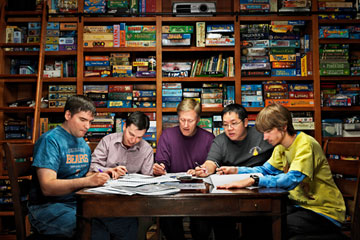
(4 of 7)
In fact, some pure-logic snobs look down on sudoku, whose rules are always the same. At the WPC, the rules of the game change from problem to problem. Each one requires a whole different set of solving strategies--the term of art is heuristics--which players often must devise on the fly. You're not just figuring out how to fix something; you're inventing the tools as you go. "What we're really measuring in this competition is who is the best at developing these heuristics rapidly, essentially as you're solving the second puzzle you've ever seen of that style," says Nick Baxter, 55, a veteran competitor who now acts as captain of the U.S. team. "How quickly you grok the subtleties and the interesting interactions between the givens and the constraints, and how you get solutions."
For example, one problem in the 2012 championship consisted of a table-size grid representing Kraljevica's harbor, on which teams had to place as many ships of three different sizes as they could in a manner that satisfied 17 separate conditions. Every boat had to touch the shore, no boat could touch any other boat, and so on. The puzzle rather starkly revealed the gulf between the Platonic world of logic and our fallen reality: picture a ballroom full of geniuses bent over stylized maps, carefully placing toy boats, one by one, in precise configurations, while in the windows the sun goes down on the actual Kraljevica harbor, standing idle and empty of any ships whatsoever--an incorrectly solved square on the global economic grid.
The Art of the Puzzle
To connoisseurs, a puzzle is like a poem, except that whereas poems deal in feelings and ideas, puzzles traffic in pure logical epiphanies. A well-constructed puzzle leads you down a particular chain of reasoning to a specific elegant or counterintuitive cognitive leap, and as you make it, you know at that moment that you're making precisely the same leap the puzzle designer did. There's a moment of silent intellectual communion, of shared aha!
Snyder got a taste of that aha! feeling when he was 14. "I was reading an account of the third world championship," he says. "They had a puzzle where the organizer was walking to the dinner area, and he was wearing a very odd shirt with various patterns and shapes. And he drops a plate and makes a commotion, and everybody's supposed to look at him and see the shirt. An hour later they were given a round where they had to reconstruct what he was wearing. And I thought, That sounds cool. I would like to do this."
But professional puzzling has never acquired the same public profile as, say, poker, or even poetry, and one reason is that at that level the puzzles are really hard. Unearthly hard--so hard that it's hard to even explain how hard they are. At the WPC there are point bonuses just for finishing all the puzzles in a single round, but not many players claim them. In 2012 one round featured 21 puzzles in which each of the answers was linked to the others, and no instructions were given for any of them; before you could solve the puzzles, you had to deduce what the rules were.
